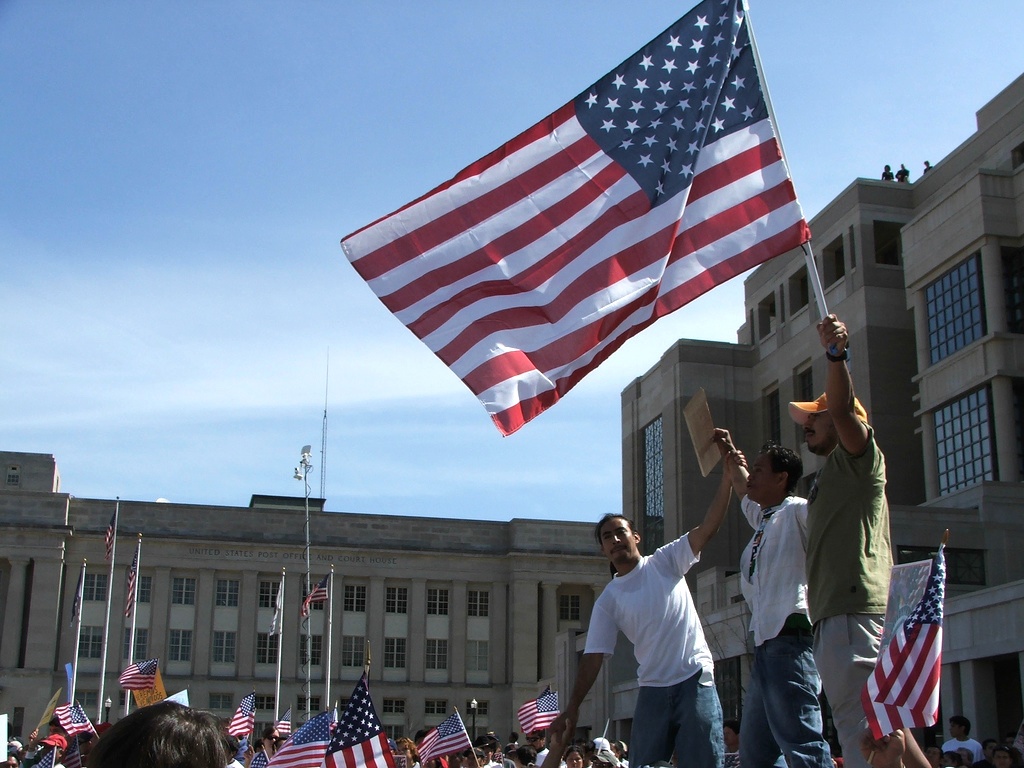VOICES: What to the immigrant is the Fourth of July?

The crowd at an immigration reform rally in Lexington, Kentucky, in 2006 chanted "Sí, se puede," "U.S.A.," and "libertad." (Photo by Britt Selvitelle via Flickr.)
On Liberty Island in New York City stands the 305-foot-tall Lady Liberty. She is holding a tablet upon which is inscribed the date July 4, 1776 — American Independence Day. A broken shackle lies at her feet, and below it is an excerpt from the Emma Lazarus poem "The New Colossus":
"Give me your tired, your poor, your huddled masses yearning to be free…"
The Statue of Liberty appears to be welcoming all those who have been oppressed — all those in search of freedom. The statue also appears to be symbolically breaking away from America's tainted history, which involved enslaving an entire group of people and deeming them property.
This year marks 240 years since the signing of the Declaration of Independence, 153 years since the signing of the Emancipation Proclamation, and 151 years since the passage of the 13th Amendment, which officially freed enslaved Blacks.
But 2016 has also shown how much progress is still to be made in guaranteeing freedom for all.
In this year's presidential race, "Make America Great Again" is the slogan of Republican presidential candidate Donald Trump. He borrowed it from Ronald Reagan, who kicked off his 1980 election campaign with a speech on state's rights in Neshoba County, Mississippi, just a few miles from where three civil rights workers were slain by the Ku Klux Klan during Freedom Summer in 1964.
Trump's politics of racial resentment — a continuation of the GOP's "Southern strategy" designed to court white voters — has also focused on Latino immigrants. He has stereotyped them as rapists and murderers, even though many are themselves fleeing rape, murder, and other violence in their home countries. He has even called for deporting 11 million undocumented immigrants and banning Muslims from entering the country.
Given the current political moment, it is more important than ever for us to resist a romanticized version of U.S. history and consider abolitionist Frederick Douglass's seething speech "What to the Slave is the Fourth of July?" — to remember all those who were not included when the Declaration of Independence was signed, and those who are still not included today.
Speaking before the Ladies' Anti-Slavery Society in Rochester, New York, on July 5, 1852, Douglass, who had escaped from slavery 14 years earlier, proclaimed, "I will, in the name of humanity which is outraged, in the name of liberty which is fettered, in the name of the constitution and the Bible, which are disregarded and trampled upon, dare to call in question and to denounce, with all the emphasis I can command, everything that serves to perpetuate slavery — the great sin and shame of America!"
Thirteen years after his speech, slavery ended in the United States. But the subjugation of its peoples continued to be perpetuated through other forms of discrimination, which left the American dream unattainable to anyone who did not meet a certain standard — to anyone who was not white, male, or native-born.
"With the emancipation of slaves," Karla Mari McKanders observed in a 2012 article in the Catholic University Law Review, "states shifted their use of police power from a pretext for discrimination against African Americans to a pretext for the discrimination of Chinese immigrants."
In Chae Chan Ping v. United States, the Supreme Court ruled in 1889 that "a returning resident non-citizen could be excluded if Congress determined that his race was undesirable." Meanwhile, Chinese immigrants who were in the United States unlawfully were dehumanized and exploited in the workplace.
Douglass himself spoke of the unjust treatment of the Chinese in an 1869 speech: "There are such things as human rights," he said. "Among these, is the right to locomotion; the right of migration; the right which belongs to no particular race, but belongs alike to all and to all alike."
Yet, in 2016, many in the United States are denied this right to migration. Some observers have even likened current U.S. immigration policies to the Fugitive Slave Acts, which required captured slaves to be returned to their masters, and which forced citizens of free states to comply.
Enforcement of the Fugitive Slave Acts left even free Blacks fearing for their safety. Today, U.S. Immigration and Customs Enforcement officials target Latino communities in ways that similarly leave even those who are documented at risk of intimidation.
Also, like enslaved people in the 1800s, many undocumented immigrants today have little hope in appealing for legal status in court, however horrific the circumstances they escaped. Consider the more than 300 Central American youth who were detained this year during raids. They fled to the U.S. as minors but upon turning 18 have been denied asylum by immigration courts and ordered back to their home countries, some of the most dangerous in the world.
In his 1852 speech, Douglass described a scene that was not uncommon during slavery: a 13-year-old being sold and torn away from her mother. Current U.S. immigration policies continue to tear apart families or force them to live in constant fear of separation.
So the question we might ask today is, "What to the immigrant is the Fourth of July?"
America is a nation that professes to welcome immigrants. The Statue of Liberty does not serve as a beacon only for the most financially stable, well dressed, or well-educated. It specifically calls to those seeking asylum — the "tired, poor, huddled masses yearning to be free."
If the U.S. truly wants to live out its ideals, it should take note of Douglass' words from his 1852 speech: "The feeling of the nation must be quickened; the conscience of the nation must be roused; the propriety of the nation must be startled; the hypocrisy of the nation must be exposed; and the crimes against God and man must be proclaimed and denounced."
Tags
Rebekah Barber
Rebekah is a research associate at the Institute for Southern Studies and writer for Facing South.
